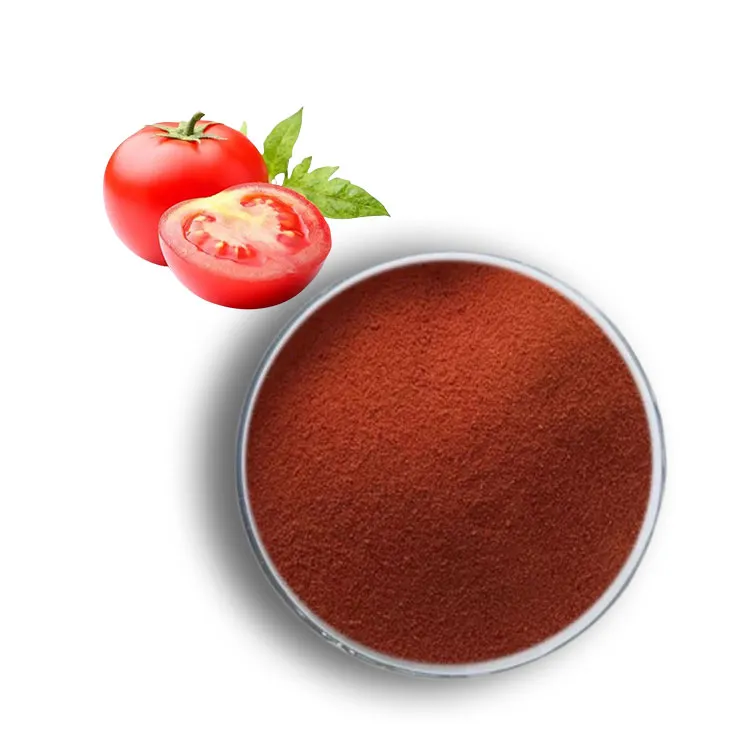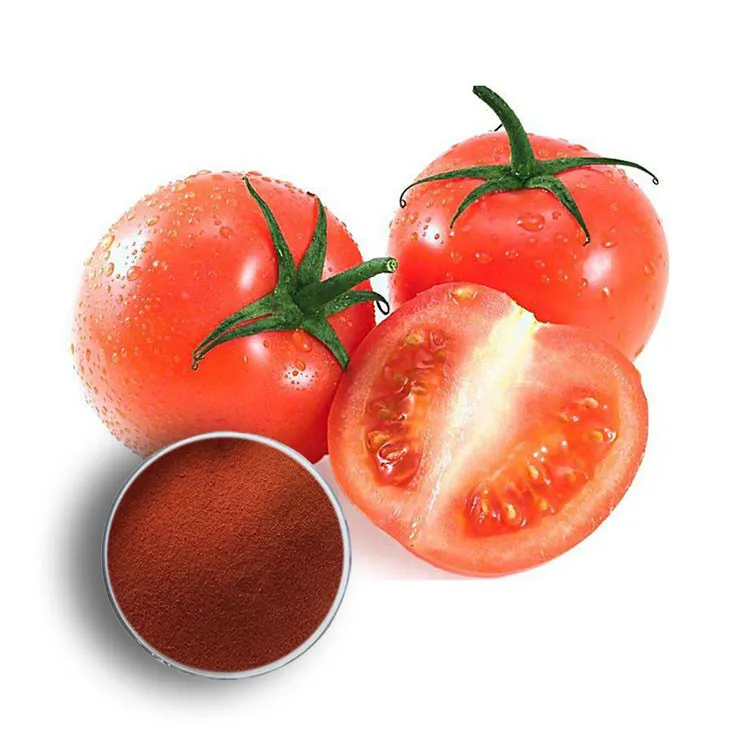- 0086-571-85302990
- sales@greenskybio.com
Lycopene Suppliers.
2024-11-30

1. Introduction to Lycopene
Lycopene is a remarkable natural substance that has gained significant attention in various industries. It is most commonly associated with tomatoes, which are a rich source of this potent antioxidant. Lycopene is responsible for the vibrant red color seen in tomatoes and many other red - colored fruits and vegetables. Its antioxidant capabilities are of great importance as they play a role in protecting cells from damage caused by free radicals.

2. The Role of Lycopene Suppliers
Lycopene suppliers are crucial players in the market. They are responsible for ensuring a steady supply of high - quality lycopene to meet the diverse demands of different industries. These suppliers act as a link between the growers of tomatoes (the primary source of lycopene) and the end - users, which include the food and beverage industry, the nutraceutical industry, and the cosmetics industry.

3. Tomato Selection by Suppliers
3.1 Importance of Reliable Growers
The first step in the process for lycopene suppliers is the careful selection of tomatoes from reliable growers. This is vital as the quality of the tomatoes directly impacts the quality of the extracted lycopene. Suppliers look for growers who follow good agricultural practices, ensure proper irrigation, use appropriate fertilizers, and control pests and diseases effectively.3.2 Factors Considered in Tomato Selection
- Tomato variety: Different varieties of tomatoes may have varying levels of lycopene content. Suppliers often prefer varieties known for their high lycopene levels.
- Ripeness: Ripe tomatoes generally have a higher concentration of lycopene. Suppliers need to ensure that the tomatoes are harvested at the optimal stage of ripeness.
- Quality control: This includes checking for any physical damage, mold, or other signs of spoilage in the tomatoes.

4. Extraction Processes
4.1 Solvent - Based Extraction
One of the traditional methods of extracting lycopene from tomatoes is solvent - based extraction. This method involves using solvents such as hexane or ethyl acetate to dissolve the lycopene from the tomato pulp. However, this method has some drawbacks.- Residual solvents: There is a risk of residual solvents remaining in the final lycopene product, which may pose a health risk if not removed completely.
- Lower purity: The lycopene obtained through solvent - based extraction may not be as pure as that obtained through other methods.
4.2 Supercritical Fluid Extraction
In recent years, supercritical fluid extraction has emerged as a more advanced method for lycopene extraction. Supercritical carbon dioxide is often used as the extraction fluid.- High quality and purity: This method can produce lycopene with higher quality and purity compared to solvent - based extraction.
- Environmentally friendly: Supercritical fluid extraction is considered more environmentally friendly as carbon dioxide is a non - toxic and easily recyclable fluid.
5. Market Demands and Adaptability
5.1 Domestic and International Markets
Lycopene suppliers need to be able to supply both the domestic and international markets. The international market may have different regulations and quality requirements compared to the domestic market.- Export requirements: Suppliers need to be aware of and comply with the import regulations of different countries, which may include requirements for product labeling, packaging, and quality standards.
- Market trends: Different regions may have different trends in the consumption of lycopene - containing products. For example, some countries may have a higher demand for lycopene in the form of dietary supplements, while others may prefer lycopene - added food products.
5.2 Different Industry Demands
- Food and beverage industry: In this industry, lycopene is used for both coloring and nutritional purposes. For example, it is added to tomato - based products such as ketchup, pasta sauce, and tomato juice to enhance their red color and also to provide the health benefits associated with lycopene. Suppliers need to provide lycopene in a form that is suitable for use in food and beverage production, which may require specific particle sizes or formulations.
- Nutraceutical industry: With the increasing consumer awareness of health and wellness, the nutraceutical industry has seen a booming demand for lycopene - based dietary supplements. Suppliers need to meet the high - quality requirements of this industry, which often include strict quality control for purity, potency, and safety of the lycopene product.
- Cosmetics industry: Lycopene is also used in the cosmetics industry, mainly for its antioxidant properties. It may be included in skincare products such as creams and lotions to help protect the skin from environmental damage. Suppliers need to ensure that the lycopene they provide is suitable for use in cosmetics, which may require additional purification steps to meet the strict quality standards of the industry.
6. Quality Assurance
Quality assurance is a critical aspect of the operations of lycopene suppliers.
- Testing and analysis: Suppliers need to conduct regular testing and analysis of their lycopene products. This may include tests for purity, potency, and the presence of any contaminants. Advanced analytical techniques such as high - performance liquid chromatography (HPLC) are often used for accurate determination of lycopene content.
- Certifications: Obtaining relevant certifications such as Good Manufacturing Practice (GMP) and ISO certifications can help suppliers demonstrate their commitment to quality. These certifications are often required by customers in the food, nutraceutical, and cosmetics industries.
- Quality control during production: This involves ensuring that all steps in the production process, from tomato selection to lycopene extraction and packaging, are carried out under strict quality control conditions. Any deviation from the set quality standards should be identified and corrected promptly.
7. Cost - Effectiveness
7.1 Cost Management in Production
Lycopene suppliers need to manage their costs effectively to remain competitive in the market. In the production process, cost - saving measures can be implemented.- Efficient extraction processes: By using more efficient extraction methods such as supercritical fluid extraction, suppliers can reduce the cost of production in the long run, despite the initial investment in equipment. This is because these methods may result in higher yields and better quality of lycopene, reducing waste and the need for re - processing.
- Supply chain optimization: Optimizing the supply chain from tomato growers to the final product delivery can also help reduce costs. This may involve establishing long - term relationships with growers to ensure a stable supply of tomatoes at a reasonable price, as well as streamlining the transportation and storage processes.
7.2 Pricing Strategies
Suppliers also need to develop appropriate pricing strategies.- Market - based pricing: Considering the market demand, competition, and cost of production, suppliers can set prices that are competitive yet profitable. For example, in a highly competitive market, suppliers may need to lower their prices slightly to gain market share, while in a niche market with high - quality requirements, they may be able to charge a premium price.
- Value - based pricing: Since lycopene has various health benefits and is used in different industries for different purposes, suppliers can also consider value - based pricing. For example, lycopene products with higher purity or special formulations targeted at specific industries may be priced higher based on the added value they provide.
8. Environmental Sustainability
8.1 Sustainable Tomato Farming
As lycopene suppliers rely on tomatoes as their primary source, promoting sustainable tomato farming is an important part of environmental sustainability.- Organic farming: Encouraging growers to adopt organic farming practices can reduce the use of chemical fertilizers and pesticides, which is beneficial for the environment. Organic tomatoes may also be preferred by some consumers, especially in the nutraceutical and food industries where there is a growing demand for organic products.
- Water conservation: Promoting water - efficient farming methods can help reduce the water footprint of tomato production. This is particularly important in regions where water resources are scarce.
8.2 Sustainable Extraction and Production Processes
- Renewable energy use: In the extraction and production facilities, using renewable energy sources such as solar or wind power can reduce the carbon footprint. For example, powering the extraction equipment with solar energy can be a sustainable option.
- Waste management: Proper waste management during the production process is essential. This includes recycling or re - using waste materials generated during lycopene extraction, such as tomato skins and seeds, which can be used for other purposes such as animal feed or bio - fuel production.
9. Conclusion
Lycopene suppliers play a vital role in the global market for this important natural substance. They face multiple challenges, including ensuring the quality of lycopene, meeting diverse market demands, managing costs, and maintaining environmental sustainability. By carefully selecting tomatoes, using advanced extraction processes, being adaptable to different markets, and focusing on quality assurance, cost - effectiveness, and environmental sustainability, lycopene suppliers can succeed in this competitive and growing market.
FAQ:
1. What are the main sources of lycopene for suppliers?
For lycopene suppliers, the main source is tomatoes. Tomatoes are rich in lycopene, which is known for its red color and antioxidant properties. Suppliers carefully select tomatoes from reliable growers to ensure the quality of the lycopene they will extract.
2. What extraction methods do lycopene suppliers use?
Lycopene suppliers use various extraction methods. These can include solvent - based methods and more advanced supercritical fluid extraction. The supercritical fluid extraction is often used to achieve higher quality and purity of lycopene.
3. How do lycopene suppliers meet different market demands?
Lycopene suppliers need to be adaptable to different market demands. For the nutraceutical market, where health - conscious consumers are a major part, they supply lycopene as a beneficial antioxidant. In the traditional food and beverage industry, lycopene is used for both coloring and its nutritional value, so suppliers must ensure they can meet the quantity and quality requirements of these different sectors.
4. Why is quality assurance important for lycopene suppliers?
Quality assurance is crucial for lycopene suppliers. High - quality lycopene is necessary to meet the standards of various industries. In the nutraceutical market, consumers rely on the quality of the product for health benefits. In the food and beverage industry, consistent quality is needed for both coloring and nutritional purposes. If the quality is not assured, it can lead to problems such as ineffective products in the nutraceutical market or inconsistent coloring in the food and beverage products.
5. How do lycopene suppliers ensure cost - effectiveness?
Lycopene suppliers ensure cost - effectiveness through several means. They start with efficient sourcing of tomatoes from growers, which can help reduce the raw material cost. In the extraction process, they may optimize the use of solvents or other extraction agents to cut down on production costs. Also, by streamlining their production and distribution processes, they can manage costs while still maintaining the quality of the lycopene.
Related literature
- Lycopene: Sources, Extraction, and Health Benefits"
- "The Role of Lycopene Suppliers in the Global Market"
- "Quality Control in Lycopene Supply Chains"
- ▶ Hesperidin
- ▶ Citrus Bioflavonoids
- ▶ Plant Extract
- ▶ lycopene
- ▶ Diosmin
- ▶ Grape seed extract
- ▶ Sea buckthorn Juice Powder
- ▶ Fruit Juice Powder
- ▶ Hops Extract
- ▶ Artichoke Extract
- ▶ Mushroom extract
- ▶ Astaxanthin
- ▶ Green Tea Extract
- ▶ Curcumin
- ▶ Horse Chestnut Extract
- ▶ Other Product
- ▶ Boswellia Serrata Extract
- ▶ Resveratrol
- ▶ Marigold Extract
- ▶ Grape Leaf Extract
- ▶ New Product
- ▶ Aminolevulinic acid
- ▶ Cranberry Extract
- ▶ Red Yeast Rice
- ▶ Red Wine Extract
-
Feverfew Extract
2024-11-30
-
Kelp Extract Powder
2024-11-30
-
Cassia Seed Extract
2024-11-30
-
Tinospora cordifolia extract
2024-11-30
-
Acerola Juice Powder
2024-11-30
-
Epimedium extract powder
2024-11-30
-
Hops Extract
2024-11-30
-
Okra Extract
2024-11-30
-
Red Vine Extract
2024-11-30
-
Sea buckthorn Juice Powder
2024-11-30





















